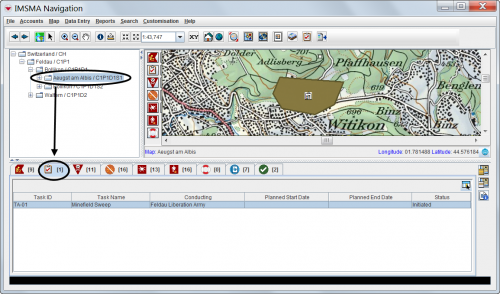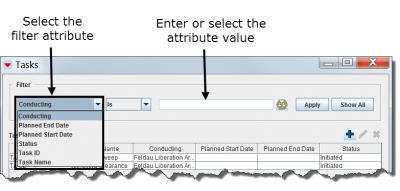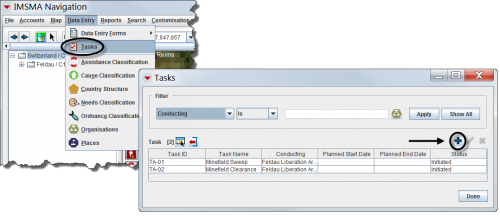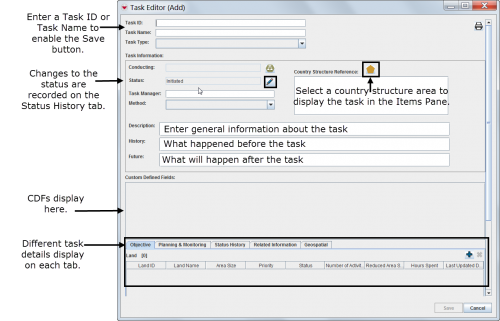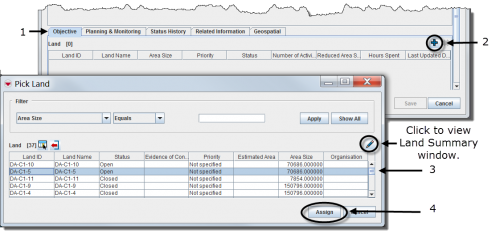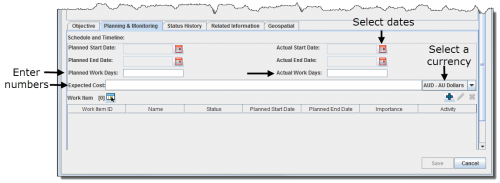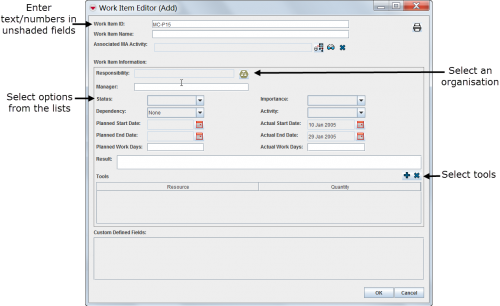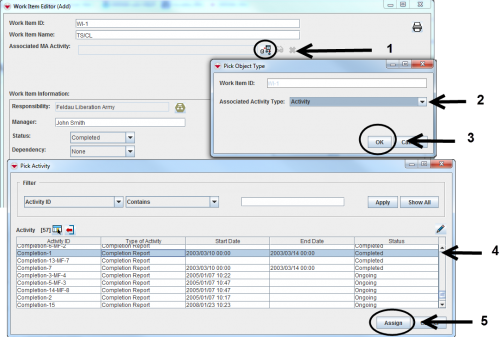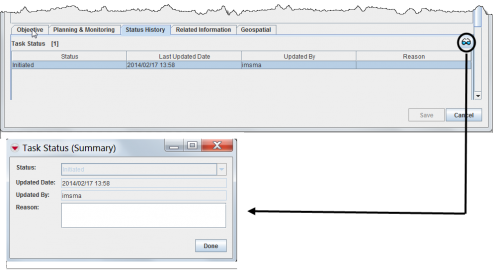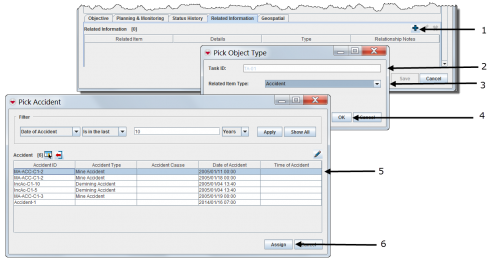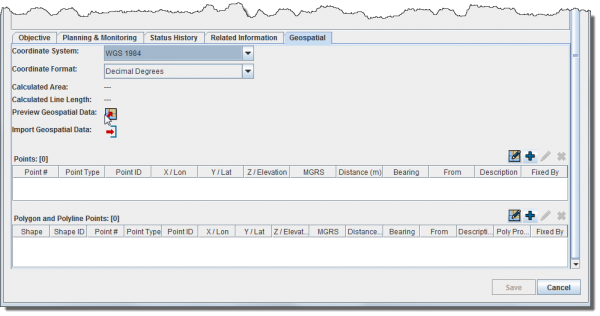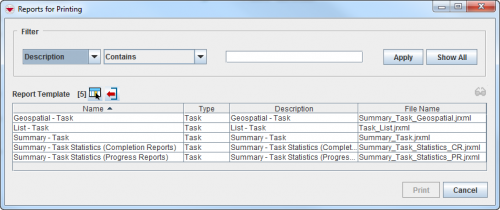Difference between revisions of "Using the Tasking Tool in IMSMANG"
| Line 115: | Line 115: | ||
====Associate the plan (Work Items) to the outcome====__NOEDITSECTION__ | ====Associate the plan (Work Items) to the outcome====__NOEDITSECTION__ | ||
| − | If the operation manager would like to compare the planned Activities (Work Item) with the outcome it is possible to link the Work Item with '''one''' | + | If the operation manager would like to compare the planned Activities (Work Item) with the outcome it is possible to link the Work Item with '''one''' approved Activity, Assistance, Education activity or QM. |
Associate an MA activity data entry form. | Associate an MA activity data entry form. | ||
| Line 121: | Line 121: | ||
[[Image:utT11.png|500px]] | [[Image:utT11.png|500px]] | ||
| + | {{New_6.0 | The new Assistance item may be associate as Work Item.}} | ||
====Viewing Task Status History====__NOEDITSECTION__ | ====Viewing Task Status History====__NOEDITSECTION__ | ||
Revision as of 04:26, 31 October 2014
Depending on local standard operating procedures (SOPs), the Tasking tool can be used to manage activities for one land or several lands, or for monitoring a specific organisation that was tasked.
All the compiled information related to the specified Task can be viewed and printed from the Task manager or the Task Editor window.
Introduction
The Tasking tool allows Mine Action Programmes to perform Task planning and tracking within IMSMANG. Tasks are created by selecting objectives (Land) and then plan work items (Activities, Assistanvce, Education activities and QMs) to it. Any other related information to the item can as well be included in the Task.
Using the Tasking Tool, operation managers can group items together for assigning mine action responsibilities to different organisations and for tracking purposes (gaining approval, conducting and monitoring).
Similar to other items, Tasks can be customised to include CDFs. Tasks, however, are somewhat different from other items in that they are entered and modified directly in IMSMANG without using Data Entry Forms or the approval process. This means that historical data about Tasks is not tracked (except for status change) and any updates made to Tasks automatically replace previous data. This provides a simplified mechanism for tracking short-term task data in addition to the traditional Data Entry Form method for other items.
Viewing Tasks
Tasks can be displayed in the items pane by selecting a specific Country Structure.
On an Item's Summary
| |
Only Land, Activities, Education and QM summaries can have associated Tasks. |
On the Tasks Window
To access the Task window, select the Data Entry menu, and then select Tasks.
Tasks Window
Filtering the Tasks Displayed
By default, all Tasks are listed in the table when the Tasks window is opened. You can limit the Tasks displayed in the table by selecting specific filter attributes.
Filtering Tasks
To filter the Tasks displayed in the Tasks window:
- From the Data Entry menu, select Tasks.
- The Tasks window displays.
- Select the attribute on which you would like to apply the filter from the Filter drop-down list. Filter options for Tasks include:
- Conducting – returns tasks owned by the organisation you selected from the list.
- Planned End Date - returns tasks with the specified end date.
- Planned Start Date - returns tasks with the specified start date.
- Status – returns tasks with the status value that you selected from the list.
- Task ID – returns tasks with a task ID that contains the specified value.
- Task Name – returns tasks with a task name that contains the specified value.
- Enter or select a value that the selected attribute must be either similar to or contain. Note that the filter is not case-sensitive.
- Click the Apply button.
- Tasks passing the filter are listed in the table.
Adding New Tasks
Completing General Information Details
Associating Objectives
| |
The objective of a Task may be a single Land or several Land items. |
- Select the Objective tab in the Task Editor window.
- Click the
 button.
button. - Select one or several Land. Note that the Land must have Status set in order to be possible to select.
- Click Assign.
| |
It is now possible to select more than one Land when associating objectives. |
Creating Work Items
| |
Work Items may be created by the operation manager and are the planned Activities foreseen by the operation manager. |
- Select the Planning & Monitoring tab in the Task Editor window.
- Enter a work item ID or work item name to enable the OK button.
- Enter general information about the work item.
Associate the plan (Work Items) to the outcome
If the operation manager would like to compare the planned Activities (Work Item) with the outcome it is possible to link the Work Item with one approved Activity, Assistance, Education activity or QM.
Associate an MA activity data entry form.
| |
The new Assistance item may be associate as Work Item. |
Viewing Task Status History
The Status History tab displays a list of status updates made to the Task. Each time a user changes the status of a Task in the Task Editor window, a new record is entered in Task Statuses table. The following information is displayed:
- The status selected at each status update.
- The date of each status update.
- The username of the person who initiated the status update.
- The reason (if provided) for the status update.
| |
You can click the |
Status History Tab
Adding Related Information
| |
It is possible to associate other items than the Objective to the Task. These items will facilitate the planning of the execution of the Task for the conducting organisation. |
- Select the Related Information tab in the Task Editor window.
- Select which type of item, Task or Auxiliary data that you would like to associate
- Assign which item, Task or Auxiliary data to associate as extra information to the Task.
Adding Geospatial Data
The geospatial data tab allows you to add, edit, delete, or import geospatial shapes (points, polygons, and polylines) associated with the Task. For more information, refer to Enter Geospatial Data.
Geospatial Data Tab
| |
The geospatial data tab is always visible in V6.0 |
Editing Tasks
To view and/or change Task information:
- From the Tasks window, select the row associated with the Task you would like to view or change.
- Click the
 button.
button. - Change the information as needed. For more information about editing the various data entry fields, refer to Adding New Tasks.
- Do one of the following:
- To save the changes you have made to the Task, click Save.
- To discard any changes you have made, click Cancel.
Printing a Task Summary
Removing a Task
| |
Not all Tasks can be removed. You cannot remove Tasks that contain Objectives or Work Items. However, you can remove Tasks that are linked to Related Information. |
To remove a Task:
- From the Tasks window, click the row associated with the Task you would like to remove.
- Click the
 button.
button. - The Verify Task Deletion window displays.
- Do one of the following:
- To delete the Task, click the Yes button.
- The Task is removed.
- To cancel the delete operation, click the No button.
